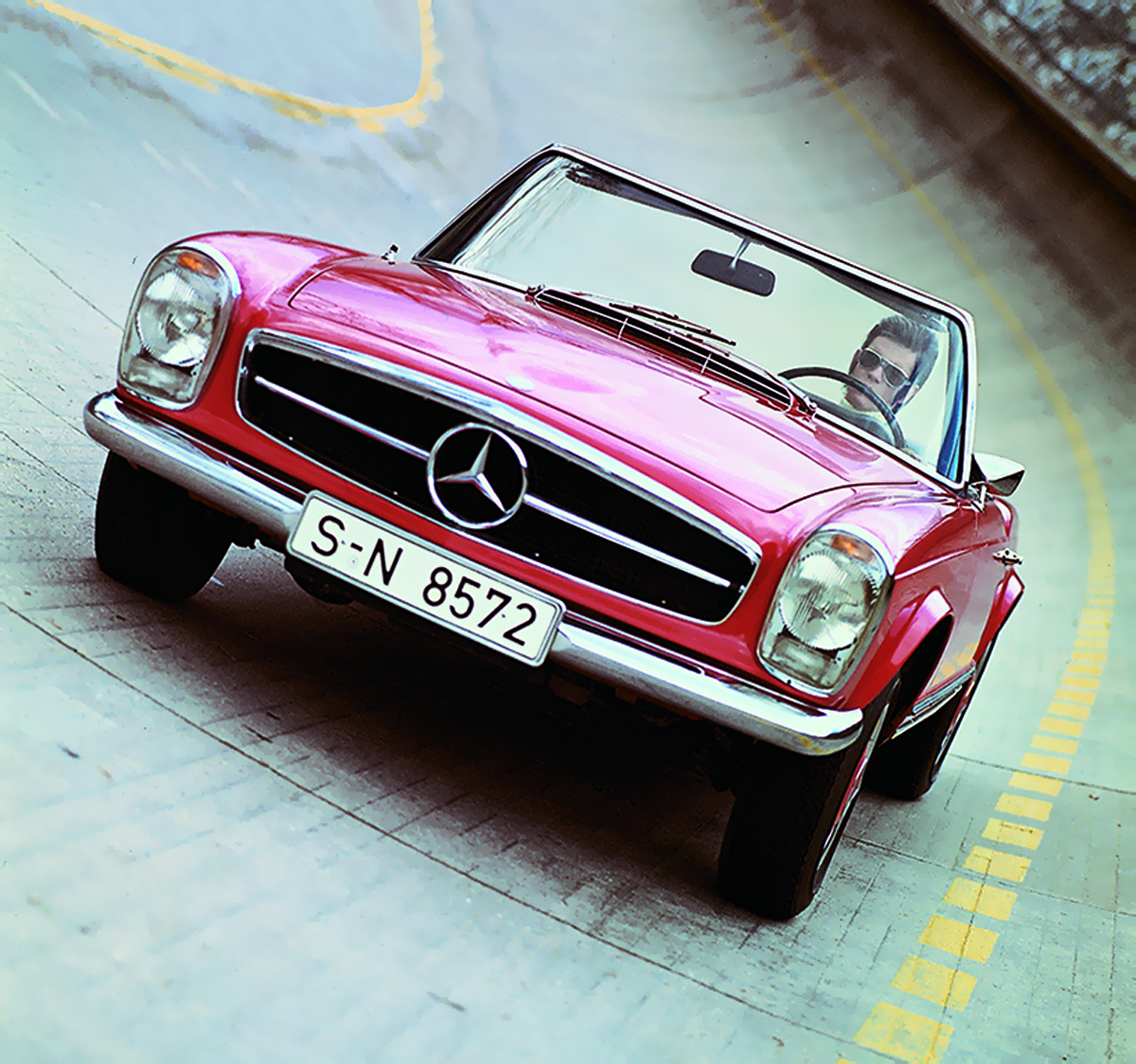
The W113, nicknamed the “Pagoda” due to its concave hardtop, has an ageless charm that remains fresh today, some 40 years after production ceased. Timelessly styled by the great Paul Bracq, the W113 is revered by many enthusiasts as his most beautiful creation.
Timeless: The W113 230SL, 250SL & 280SLs • 1963-1971
In praise of the eternally appealing Pagoda
Article Richard Simonds, Michael Salemi
Data tables Daniel Stahl
Images Daimler Archives
The W113, nicknamed the “Pagoda” due to its concave hardtop, has an ageless charm that remains fresh today, some 40 years after production ceased. Timelessly styled by the great Paul Bracq, the W113 is revered by many enthusiasts as his most beautiful creation.
The Pagoda was introduced to the world as the 230SL, the first modern-production SL in the Mercedes-Benz lineup. While the 300SL was an extravagant hand-built car with racing heritage, and the 190SL was a popular good-looker – but underpowered and looking like the cars of the decade from whence it came – the W113 brought the SL line into the modern era.
Despite development that started in 1960, Mercedes-Benz implemented innovative technology that included fuel injection, disc brakes, and specially designed semi-radial tires to work with a suspension custom-tuned for them.
Background
In 1960, the 300SL was aging and expensive, with worthy competition coming from Jaguar and Jensen. Even the more affordable 190SL was out-performed by MGs, Triumphs and Austin-Healeys costing much less.
Still, Mercedes-Benz management needed a strong business case to authorize a replacement. Rudolf Uhlenhaut did the convincing and then led a development team that included Fritz Nallinger, Karl Wilfert, Friedrich Geiger, Béla Barényi, Bruno Sacco and Bracq. This stellar group created most of Mercedes-Benz’s notable projects of the 1960s. The new SL (W113) replaced both the 190SL and the 300SL, incorporating characteristics of both earlier cars.
Management required the use of as many existing sedan parts as possible. The M127 engine from the 220SE sedans was bored to 2.3 liters. Many suspension and mechanical components came from the W111. The unitized structure featured a “safety body” with crumple zones and other passive-safety schemes devised by Barényi – the first two-seater so equipped. Front and rear subframes held the engine and suspension. Barényi and Bracq patented the hardtop’s concave roof that allowed easier access and offered strong rollover protection. Junior engineers immediately noticed the resemblance to Japanese-temple architecture and nicknamed the car the Pagoda.
Uhlenhaut required exceptional modern handling and ride comfort. He employed the low-pivot swing axle of previous SLs, but to compensate, needed stiff-sidewall radial tires that did not yet exist. He convinced Firestone-Phoenix and Continental to develop them; the new P110 and RA60 185-HR14 tires combined both bias and radial plies, with stiff sidewalls. For the time, this gave the car a wide sure-footed stance when compared with other roadsters.
The W113’s mechanical fuel injection is a six-plunger Bosch unit driven at half engine-speed, injecting fuel into the head behind the intake valves. Even today, this pump is a reliable, technical marvel. Brakes were power-assisted with dual-circuit Girling front discs and rear drums on the 230SL, changing to four-wheel ATE discs in the 250 and 280SL.
While “SL” means “Sport Leicht,” at 2,900 pounds, the Pagoda is hardly light, and not precisely sporting. Lavish use of chrome and veneered wood trim delighted the owner. The result was a well-mannered, upscale touring car for two that envelops its occupants in period luxury. Most cars were fitted with soft tops and equipped with removable hardtops, ensuring year-round motoring comfort.
Reasons to buy
Timeless design: A head-turner no matter where you go, appreciated by many famous owners known for their good taste. Arguably, this design may be considered Bracq’s finest.
Availability of parts: Most OEM parts are available from the Mercedes-Benz Classic Center; aftermarket parts are available from numerous sources. Many parts are cheaper to replace than to repair.
Modern amenities: Most Pagodas feature power steering, power brakes and automatic transmissions, providing a modern ride and feel.
Active clubs: Clubs and forums such as MBCA, SL113.org, and others have friendly owners who share their knowledge and provide a centralized source of information.
Expert restorers: A robust group of expert restorers ensures survivability and correctness.
Sweet spot of production: The 300SL is rare and costly, and the 190SL is noticeably older in design and engineering. The Pagoda inhabits a sweet spot between the rare and the plentiful with enough high-end engineering, styling and performance to be drivable today.
Reasons not to buy
Parts prices: The cost of some Pagoda-specific components has skyrocketed in recent years, making the attainment of a 100-percent complete and correct restoration a frightfully expensive proposition for most owners.
Parts availability: Some parts are “NLA” (no longer available). If you’re fortunate, you might be able to find an NLA part that can either be repaired or restored for reuse.
Sorting it out: The time and cost of correcting a previous owner’s mistakes, intentional or otherwise, can be daunting.
Drivetrain: The automatic transmission was an early design with abrupt shifting. The engine turns at a loud 3,500-4,000 rpm at highway cruising speed, depending upon rear-axle ratio.
Checkpoints
Rust: Rust is a major problem. Extensive rust may render the W113’s unit-body chassis unrepairable. The novice looking to buy a Pagoda will wisely seek expert advice and inspection prior to purchasing a vehicle.
Engine: A leak-down and compression test will provide a basis for evaluating engine health.
Other mechanicals: Evaluate all mechanical systems, as rebuilding the brakes, suspension, engine, fuel system and other mechanicals will be costly – making a little rust by comparison not look so bad.
Drivetrain: Owner fixes to the characteristic high rpm at cruising speeds can include overdrives, non-original transmissions, and differentials from other Mercedes-Benz cars. As the model becomes more valuable, these non-original changes may negatively affect resale value.
Body work: The Pagoda has aluminum door skins, tonneau (soft top cover), hood and trunk deck, so using a magnet to detect body filler will not help you. Visible rust can be found in and around the headlamps and wheel arches, atop fenders, inside the engine compartment along the inner fender panels, front floors under the carpet, underneath the rear parcel shelf, and inside the trunk under the mat. Many cars of the era rust in the same places; skilled restorers know where to look and which tools to employ for assessment. Worse than visible rust is rust hidden beneath undercoating, paint or plastic body filler.
Engine operation: A well-sorted engine will start easily, idle smoothly at approximately 750 rpm when warm, and accelerate briskly. It will not smoke when running. Rough starting, poor idle, and hesitation can be signs of ignition, electrical, or fuel issues – or worse, all three. When the cold-start injector is engaged (cold engine), expect idle to be a little high, rough or both. Look for poor engine work; shortcuts, such as doing only a valve job when a full rebuild was needed, or machining the head beyond specification, are not atypical. Poorly adjusted fuel injection, mixture, and linkages are common and have a serious effect on drivability.
Buzzing at speed: The high-rpm cruising speed of both automatic- and manual-transmission Pagodas is often mentioned as an area of concern. The best fix of all is to not consider the engineering of the drivetrain a problem needing a solution; these engines are well designed and quite capable of operating at high rpm for long periods.
Manual transmission: The Holy Grail for some Pagoda collectors is the rare ZF 5-speed manual transmission. Parts for this transmission have become nearly unobtainable, making repair almost impossible; if you find one, ensure it is solid and performs well. ZF did announce that it would make another batch of these transmissions, as well as spare-parts kits. If this transmission is a must-have for you, inquire as to whether they’re still available. Rebuilding a ZF 5-speed, if you can find anyone who can do it, will be prohibitively expensive.
Finally
Pagodas are true collectibles; if you buy carefully, you can acquire an investment asset – as well as an enjoyable car. Values peaked in 2016, with values of 280SLs recently dropping the most: Get as original and well-maintained an example as you can, regardless of model. Learn as much as you can prior to purchase, and seek expert assistance through your local section and the Pagoda SL Group www.SL113.org. Ask the registered owner for the Data Card to get original build information, chassis and engine numbers, as well as accessories included at the factory.
Don’t fixate too much on any one model; values and characteristics won’t override condition, originality and completeness – including loose parts like tools – in determining value. Be wary of examples that have not been used for a long period of time; these may take more work to restore than well-maintained, high-mileage cars.
Specifications: Mercedes-Benz W113 Pagoda SL • 1963-1971
MODEL 230SL 250SL 280SL
YEARS 1963-1967 1966-1968 1967-1971
CHASSIS 113.042 113.043 113.044
ENGINE 1.2L I-6 OHC 2.5L I-6 OHC 2.8L I-6 OHC
127.981 129.982 130.983
HORSEPOWER 170 170 180
TORQUE lb-ft 159 173 193
TRANSMISSION 4M / 4A 4 or 5M / 4A 4 or 5-M / 4-A
REAR AXLE 3.75 (3.69, 3.92) 3.69 (3.92, 4.08) 4.08 (3.69, 3.92)
TIME 0-62mph 11-13 sec 11-13 sec 10-11 sec
TOP SPEED M121 A118 121M-118A 121M-118A
MPG 14 14 14
Chronology
1963 March 230SL introduced at Geneva Auto Show
1963 July 230SL production starts
1966 November 250SL production starts
1967 January 230SL production ends
1967 November 280SL production starts
1968 January 250SL production ends
1971 March 280SL production ends
Note: There were numerous production changes in components over the eight years of W113 production; citing all of these would require several pages, far more than space allows.
Laurence Meredith, Original SL: The Restorer’s Guide to 300SL, 190SL, 230/250/280SL models to 1971, Breford, Devon, UK. 1996. ISBN 1 870979 66 4, is a source for production changes described in minute detail.
Production Totals – 1963-1971
YEAR 230 SL 250 SL 280 SL PRODUCTION
1963 1,465 1,465
1964 6,911 6,911
1965 6,325 6,325
1966 4,945 17 4,962
1967 185 5,177 143 5,505
1968 2 6,930 6,932
1969 8,047 8,047
1970 7,935 7,935
1971 830 830
TOTALS 19,831 5,196 23,885 48,912

1963-1971 W113 Pagoda SL




Every aspect of the Pagoda SL, from the shape of the door handles to the placement of the exhausts, exhibits Paul Bracq’s elegant touch with stance, proportion, line, volume and trim.

1963-1971 W113 Pagoda SL
